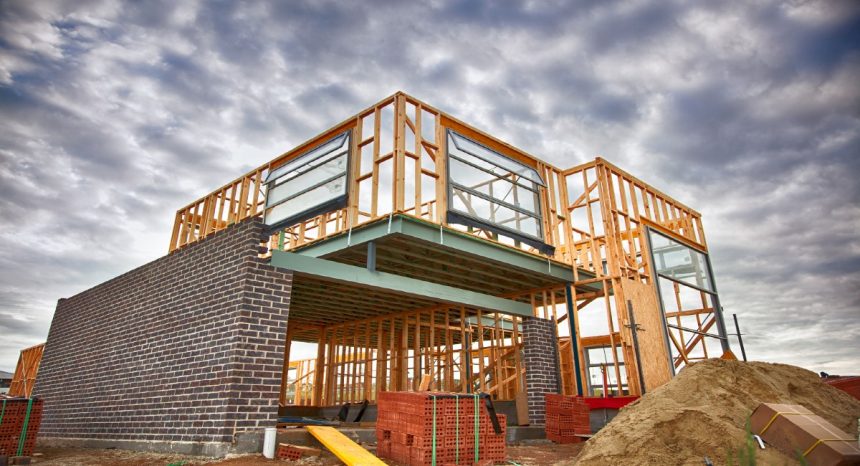Home building approvals are lagging 50 per cent behind soon-to-be annual target levels, in a concerning continuation of the nation’s housing crisis.
Less than two months out from the start of the Federal Government’s National Housing Accord, the construction of new homes remains well off the pace of the impending targets.
Worrying data released earlier month showed house approvals for new detached homes plummeted to a 12-year-record low in March.
The statistics paint a concerning picture of the nation’s housing crisis just seven weeks from the introduction of the agreement, with the goal of building 1.2 million new homes by the end of the decade.
Australia’s construction sector will need to meet an annual target of 240,000 new homes to satisfy the accord proposals, a number that significantly exceeds current building rates.
Only 161,500 new homes have been approved over the last year, 78,500 shy of the soon be annual targets.
Build targets could be over-ambitious
The miserable metrics are set to add fuel to the fire of experts’ forecasts of failure, who say, at best, the industry will only deliver a little over 1 million new homes by 2030.
Meanwhile, more pessimistic predictions, such as those from the Housing Industry Association’s modelling, predict a shortfall of 200,000 homes by the accord’s conclusion.
Master Builder’s Australi CEO Denita Wawn says there are too many hurdles preventing new home approvals.
“Despite the will of governments to get home-building activity moving, there are still too many obstacles in our way,” she said.
“Chronic tradie shortages, planning and licensing delays, draconian industrial relations changes, material cost inflation, inefficient regulation, unfeasible lending practices and risk allocation are making projects unsustainable.”
Ms Wawn called on the federal and state governments to address some of the speed bumps slowing down the construction of new homes to give the sector the best chance of meeting the ambitious goal.
“The Accord takes effect in less than two months, and if we are going to have any chance of meeting this target, we need to lift new home building by 50 per cent from current levels over the next five years,” she said.
“We have to make it easier to build new homes by bringing down the cost of construction. This must be a priority in the upcoming Federal Budget.”
The NHA Federal Government commitments:
- The Commonwealth will provide $3.5 billion in payments to state, territory and local governments to support the delivery of new homes.
- The Commonwealth has provided a one‑off $2 billion payment to states and territories through the Social Housing Accelerator payment to increase in the stock of social housing.
- The Commonwealth will provide $350 million over 5 years from 2024 to support an additional 10,000 affordable 7 star energy efficient homes.
- The Commonwealth will provide concessional loans and grants through Housing Australia to support more social and affordable housing.
- The Commonwealth will work with Community Housing Providers and other relevant not‑for‑profit housing providers to ensure achievement of targets.
- The Commonwealth is undertaking a whole‑of‑government process to identify surplus Commonwealth land that could be used to support more housing.
- A review from the interim National Housing Supply and Affordability Council (Council) on 9 May 2023 into barriers to institutional investment, finance and innovation in housing.
Slow building approvals a continuing trend
The slow volume of home construction approvals is a continuation of what was seen through 2023, with Housing Industry Association Chief Economist Tim Reardon saying rising interest rates were a key reason behind the continued reduction.
“The rise in the cash rate is the primary cause of this slowdown in approvals,” Mr Reardon said.
“Approvals have declined across all jurisdictions. However, there is an increasing divergence among the jurisdictions as the rise in the cash rate falls disproportionately on those markets with higher land costs.”
But reduced building approvals aren’t the construction sector’s only major concern ahead of the target’s introduction.
A significant trade shortage of skilled workers will also need to be addressed in order for Australia to reach its goal of 1.2 million homes by 2030.
BuildSkills Australia – a group tasked by the government to find solutions to the construction industry’s workforce challenges – says the government would need to build 60,000 new homes each quarter, requiring an additional workforce of 90,000 skilled tradies.
“Next quarter, we’re not going to be able to achieve that 60,000 run rate, which means that in future quarters, we’re going to have to deliver more to make up for what we don’t do at the front end of the program,” BuildSkills Australia group executive director Robert Sobyra said.
“The level itself is not out of the realms of possibility, but getting up to that level as quickly as we need to, that’s going to be the very difficult part.”
“So, we really need to be looking at every lever at our disposal to mobilise the workers that will be needed to achieve this objective.”







